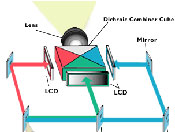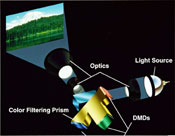Resource Guide Homepage
Resource Guide Homepage
Video Projectors
Projection has become an increasingly common mode of display for video artworks, both in darkened galleries and in cinematic or theatrical settings. Video projectors have advanced dramatically over the past 10 years. Today, important specifications to keep in mind when acquiring or renting a projector include resolution, throw distance, and video/audio inputs. Projector brightness is measured in ANSI lumens. A minimum of 1200 lumens is recommended for projections that will compete with ambient light. The more ambient light in your exhibition space, the higher a lumen count will be necessary to project a strong image. Click here for a useful lumen guide. Brightness uniformity is the percentage of brightness present from corner to corner and edge to edge of the projected image. A uniformity rating of 85 percent or better will yield a consistent image. Projector bulbs have an expected operating time, called lamp life, which is measured in hours. Newer models claim 4,000 hours of lamp life. It is recommended to keep a record of how much use your bulb has endured in order to avoid a bulb burning out in the middle of an exhibition or screening. There are two major types of projectors: liquid crystal display (LCD) and digital light processing (DLP).
Projection Screens
Well-designed projection screens will reflect more light than a matte-white wall; some screens are also designed to alleviate ambient light problems. The term "gain" is used to describe the amount of light reflected by the screen, using a matte-white wall as a reference. Use of a screen or projection paint increases an image's brightness and contrast by efficiently directing the projected light at the viewer.
LCD (liquid crystal display) projectors are thought to offer better color accuracy and exhibit superior light efficiency over DLP.

